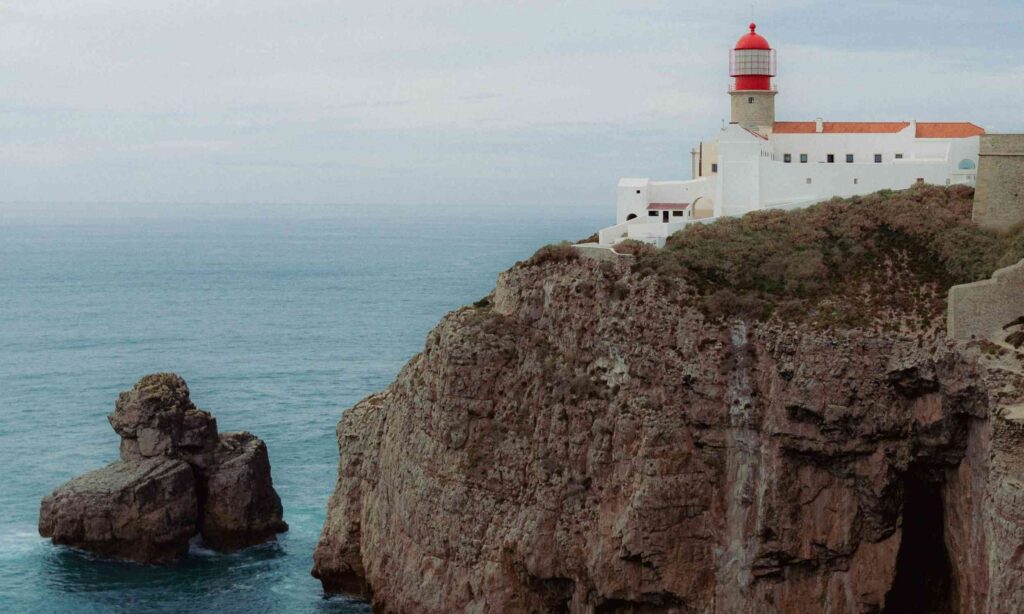At the southwestern tip of Portugal lies Sagres, a windswept town perched on dramatic cliffs overlooking the Atlantic Ocean. Known for its raw natural beauty, seafaring history, and adventurous spirit, Sagres feels like the “end of the world”—a place where land and sea meet in wild harmony. Once the launchpad of Portugal’s Age of Discoveries, today it attracts surfers, nature lovers, and travelers seeking authenticity away from crowded resorts.

A Glimpse into History
Sagres holds an outsized role in Portugal’s maritime past. In the 15th century, it was closely associated with Prince Henry the Navigator, who established a navigation school here that contributed to Portugal’s Golden Age of exploration. From these shores, sailors set out into the unknown, mapping new worlds and trade routes.
Key historic sites include the Fortaleza de Sagres, a 15th-century fortress overlooking the sea, with its iconic “rosa dos ventos” (compass rose) etched into the ground, and Cape St. Vincent (Cabo de São Vicente), long considered the edge of the known world before the discovery of the Americas.
Nature at Its Wildest
Sagres is located within the Vicentine Coast Natural Park (Parque Natural do Sudoeste Alentejano e Costa Vicentina), one of Europe’s best-preserved coastlines. Towering cliffs, secluded coves, and rolling waves define the landscape. Unlike other parts of the Algarve, Sagres has remained largely untouched by mass tourism, making it a haven for those who prefer rugged beauty to polished resorts.
The dramatic sunsets at Cape St. Vincent are legendary—the sky melting into fiery hues over the endless Atlantic is a must-see experience.
Surfing and Adventure
Sagres is a mecca for surfers, with waves suitable for all levels. Beaches like Praia do Tonel, Praia do Beliche, and Praia da Mareta are popular surf spots, offering different conditions depending on wind and swell direction. Numerous surf schools and camps make it an excellent place to learn or refine your skills.
For non-surfers, Sagres offers plenty of adventure: cliffside hikes, birdwatching, kayaking, and boat trips to explore hidden grottoes and sea caves.
Culinary Highlights
Despite its small size, Sagres has a vibrant food scene, heavily influenced by the sea. Freshly grilled fish, octopus salad, and “cataplana” (a seafood stew cooked in a traditional copper pot) are menu staples. Local taverns also serve hearty stews and regional wines from the Algarve and Alentejo.
Don’t miss pairing your meal with a glass of Sagres beer—yes, the town lends its name to one of Portugal’s most famous brews.
A One-Day Itinerary in Sagres
If you only have a day to explore Sagres, here’s how to make the most of it:
Morning
-
Start at the Fortaleza de Sagres to learn about the town’s maritime heritage and take in sweeping ocean views.
-
Walk along the cliffs for photos of the coastline’s raw beauty.
Midday
-
Head to Praia da Mareta for a relaxing beach stroll or a swim in calmer waters.
-
Enjoy a seafood lunch at a local restaurant—try octopus rice or freshly grilled sardines.
Afternoon
-
Drive or cycle to Cape St. Vincent, Europe’s southwesternmost point. Visit the lighthouse and admire the dramatic cliffs.
-
For adventure, join a surf lesson at Praia do Tonel or go for a kayaking trip along the rugged coastline.
Evening
-
Return to Cape St. Vincent or Fortaleza de Sagres for the sunset experience—a breathtaking display of colors where the sky meets the endless ocean.
-
End your day with dinner in town, perhaps at a cozy tavern serving Algarve specialties.
Sagres is not just a destination—it’s an experience of Portugal at its most untamed. With its historical importance, wild landscapes, and adventurous energy, Sagres offers a striking contrast to the Algarve’s busier beach towns. Whether you’re chasing waves, chasing history, or simply chasing sunsets, Sagres promises an unforgettable journey at the edge of Europe.
